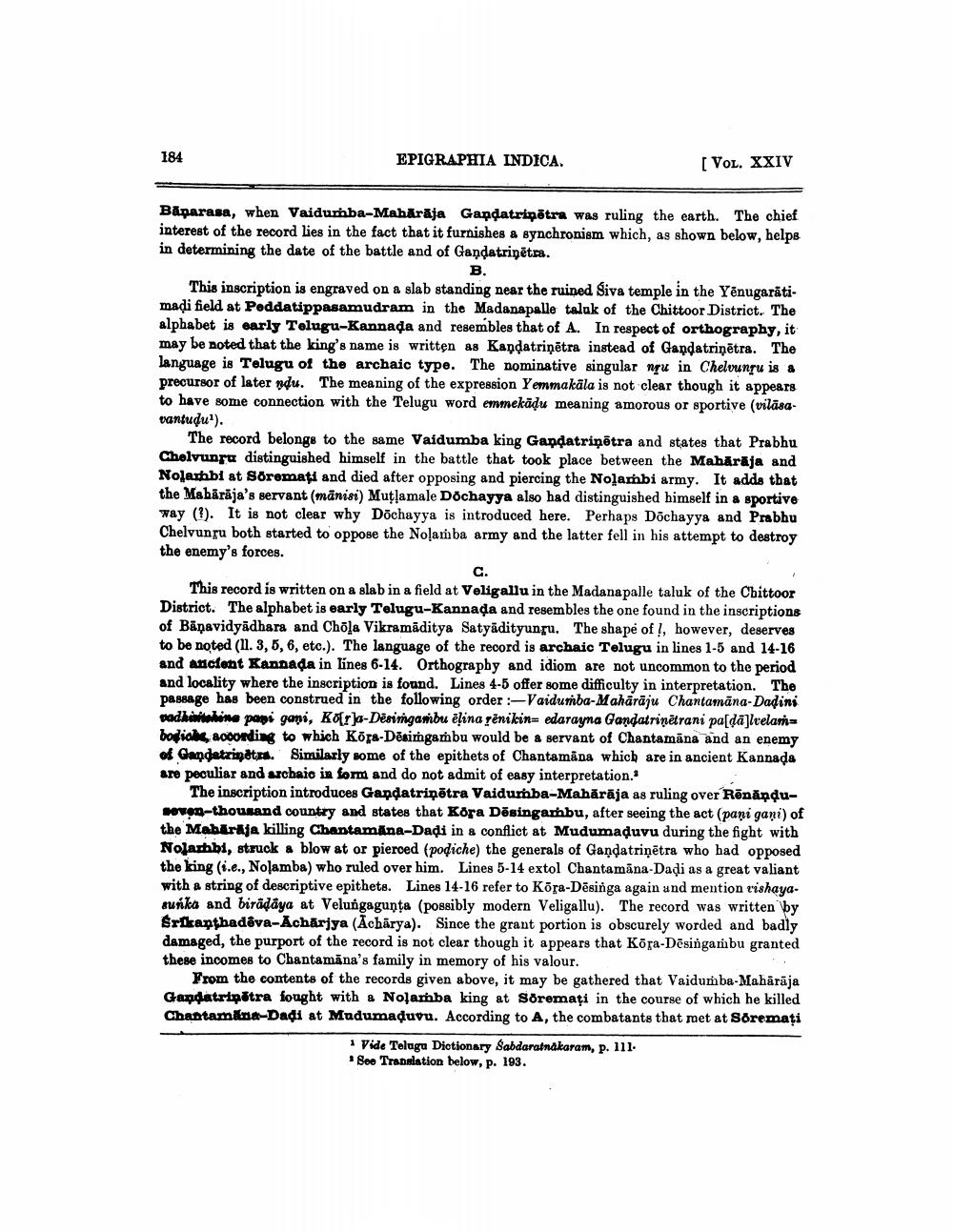________________
184
EPIGRAPHIA INDICA.
[VOL. XXIV
Banarasa, when Vaidumba-Mahārāja Gandatrinētra was ruling the earth. The chief interest of the record lies in the fact that it furnishes a synchronism which, as shown below, helps in determining the date of the battle and of Gandatrinētra.
B.
This inscription is engraved on a slab standing near the ruined Siva temple in the Yēnugarātimadi field at Peddatippasamudram in the Madanapalle taluk of the Chittoor District. The alphabet is early Telugu-Kannada and resembles that of A. In respect of orthography, it may be noted that the king's name is written as Kandatrinētra instead of Gandatrinētra. The language is Telugu of the archaic type. The nominative singular nru in Chelvunru is a precursor of later ndu. The meaning of the expression Yemmakala is not clear though it appears to have some connection with the Telugu word emmekādu meaning amorous or sportive (vilāsavantuḍu1).
The record belongs to the same Vaidumba king Gandatrinētra and states that Prabhu Chelvunru distinguished himself in the battle that took place between the Mahārāja and Nolarbi at Söremati and died after opposing and piercing the Nolambi army. It adds that the Mahārāja's servant (mänisi) Mutlamale Dochayya also had distinguished himself in a sportive way (?). It is not clear why Dochayya is introduced here. Perhaps Dochayya and Prabhu Chelvunru both started to oppose the Nolamba army and the latter fell in his attempt to destroy the enemy's forces.
C.
This record is written on a slab in a field at Veligallu in the Madanapalle taluk of the Chittoor District. The alphabet is early Telugu-Kannada and resembles the one found in the inscriptions of Bapavidyadhara and Chōla Vikramaditya Satyadityunru. The shape of, however, deserves to be noted (11. 3, 5, 6, etc.). The language of the record is archaic Telugu in lines 1-5 and 14-16 and ancient Kannada in lines 6-14. Orthography and idiom are not uncommon to the period and locality where the inscription is found. Lines 4-5 offer some difficulty in interpretation. The passage has been construed in the following order :-Vaidumba-Mahārāju Chantamana-Dadini vadhisitahina pasi gani, Korja-Desimgambu elina renikin edarayna Gandatrinetrani pa[da]lvelambogiche, according to which Kōra-Desimgambu would be a servant of Chantamana and an enemy of Gandatrinetra. Similarly some of the epithets of Chantamana which are in ancient Kannada are peculiar and archaic in form and do not admit of easy interpretation.
The inscription introduces Gandatrinētra Vaidumba-Mahārāja as ruling over Renanduseven-thousand country and states that Kōra Desingarbu, after seeing the act (pani gani) of the Mahārāja killing Chantamana-Dadi in a conflict at Mudumaḍuvu during the fight with Nolarhbi, struck a blow at or pierced (podiche) the generals of Gandatriņētra who had opposed the king (i.e., Nolamba) who ruled over him. Lines 5-14 extol Chantamana-Dadi as a great valiant with a string of descriptive epithets. Lines 14-16 refer to Kōra-Desinga again and mention vishayasunka and biradaya at Velungagunța (possibly modern Veligallu). The record was written by Srikanthadava-Acharjya (Acharya). Since the grant portion is obscurely worded and badly damaged, the purport of the record is not clear though it appears that Kōra-Desingambu granted these incomes to Chantamana's family in memory of his valour.
From the contents of the records given above, it may be gathered that Vaidumba-Mahārāja Gandatrinētra fought with a Nolamba king at Söremați in the course of which he killed Chantamana-Dadi at Mudumaḍuvu. According to A, the combatants that met at Soremați
* Vide Telugu Dictionary Sabdaratnakaram, p. 111. See Translation below, p. 193.




